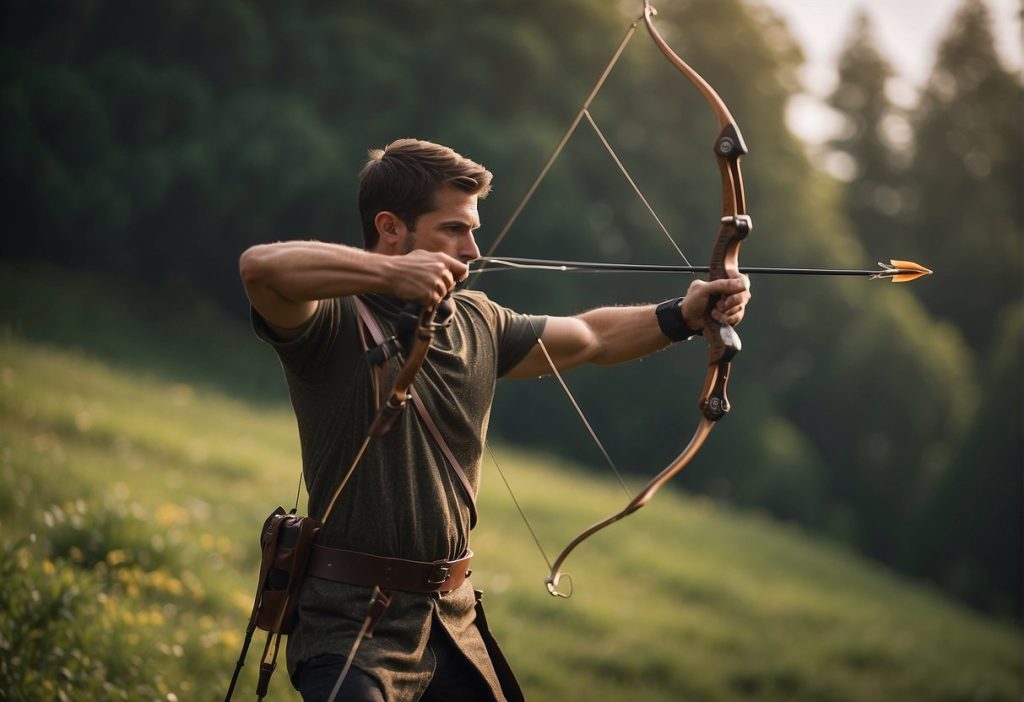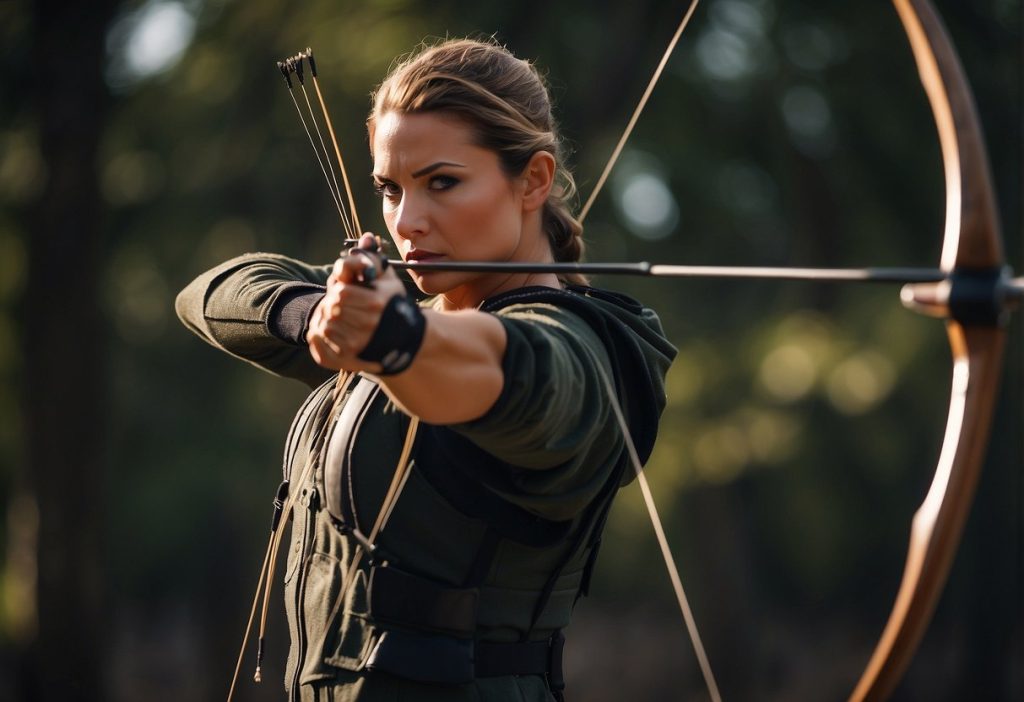
Mastering the longbow, a weapon steeped in history, is both an art and a science. This ancient bow, typically taller than the archer, has been used for centuries for hunting and warfare. Its design has not significantly changed since its first longbow appearance, emphasizing the timeless technique and skill involved in its use. For modern longbow archers, understanding the fundamentals of posture, aiming, and release is essential to achieving accuracy and control.
While the longbow may appear deceptively simple, its mastery requires diligent practice and attention to detail. A correct stance forms the foundation of effective shooting; traditional archers must stand perpendicular to the target with feet shoulder-width apart. Aiming techniques like gap shooting and string walking can greatly enhance precision, with archers learning to adjust for distance and pull force. With each shot, the archer’s connection to the rich history of the longbow is reaffirmed, bridging the gap between ancient skill and contemporary sport.
Understanding the Longbow
The longbow is a classic weapon steeped in history, revered for its height, strength, and the skill it requires. Mastering its use starts with a thorough appreciation of the different styles, how to select one, and its various components.
Utilizing the longbow involves mastering the technique of drawing and releasing the arrow with precision and accuracy. Learning the historical significance of the longbow in battles provides insight into its effectiveness as a weapon.
Appreciating the craftsmanship behind creating a longbow sheds light on the skill and dedication required to craft such a powerful weapon. Understanding the longbow in its entirety requires delving into both its practical use and cultural significance.
Types of Longbows
English Longbow: This iconic self bow is made from a single piece of wood, traditionally yew, and is characterized by its D-shaped cross-section. It played a central role in medieval warfare.
Flat Bows: Compared to the English longbow, flat traditional bows have a wider and flatter limb design. They distribute stress more evenly along the wood, which can be beneficial for beginner archers.
Modern Longbows: Today’s long bows often incorporate contemporary materials like fiberglass, offering enhanced performance and durability.
Choosing Your First Bow
Selecting a first bow requires attention to detail and personal consideration. Factors include:
- Draw weight: A lighter draw weight allows for building technique without strain.
- Length: The bow should roughly match the archer’s height for comfort and efficacy.
- Material: Choices range from traditional woods to modern composites.
The Anatomy of a Longbow
A longbow’s anatomy is relatively straightforward, yet each part is critical for functionality and performance. Key elements include:
- Stave: The main body, typically as tall as the archer. The stave of a longbow must be carefully selected and crafted to ensure proper flexibility and strength for optimal performance in archery.
- Limb: The upper and lower ends that flex when drawing the bow. Using a limb of a longbow requires careful handling and precise aim, ensuring accuracy and power in each shot.
- String: The cord that, when pulled, propels the arrow. It’s often made of durable materials like Dacron for longevity. Using a longbow involves pulling back the string and releasing it to propel the arrow forward with accuracy and force.
Advice on the specifics of longbow use can be found on websites dedicated to the craft, such as tips and tricks on Archery Care and detailed guides and mistake corrections on Archery Gear Hub.
Mastering the Basics

Before delving into the details of longbow shooting, one must solidify their understanding of proper form and technique, draw length and weight, and the basic traditional archery stance. These foundational skills are pivotal for accuracy and effectiveness.
Proper Form and Technique
Achieving a proper form is critical for successful longbow shooting. They should always maintain a straight posture with relaxed shoulders. The arm holding the bow should be straight but not locked, allowing the energy of the full draw to flow freely. When drawing the bow, they must use their back muscles rather than their arms to ensure good form and prevent fatigue.
Mastering the proper form and technique of the longbow involves consistent practice and attention to detail. Perfecting your stance, grip, and release will greatly improve your accuracy and overall performance.
Draw Length and Draw Weight of the Bow
Selecting a longbow with the appropriate draw weight is essential. They should choose a weight that allows for a full, smooth draw without strain. The draw length is just as vital; an overly long or short draw can hinder performance. They should measure their draw length by stretching their arms out to form a ‘T’ and dividing their wingspan by 2.5 to find the correct bow size.
Basic Archery Stance
The basic archery stance sets the stage for a stable shot. They should place their feet shoulder-width apart, perpendicular to the target, forming an open stance. They must distribute their weight evenly on both feet, maintaining balance throughout the shot. This stable base is key to a consistent shooting routine.
Advanced Shooting Techniques
Mastering advanced shooting techniques in longbow archery involves a deep understanding of various aiming methods, the ability to shoot accurately at different distances, and a commitment to consistency in practice. These areas are critical for those seeking to elevate their longbow skills beyond the basics.
Aiming Method
Gap Shooters: This precise aiming technique involves estimating the distance between the archer’s eye, the arrow tip, and the target. Archers using gap shooting must calibrate their sight picture based on the distance to the target, ultimately developing an intuitive sense for alignment and trajectory.
Instinctive Shooting: A less mechanical approach, instinctive shooting relies on the archer’s subconscious familiarity with the bow and arrow. The archer focuses on the target while letting the body naturally align the shot, which can be highly effective with diligent practice.
Shooting at Different Distances
Variable distance practice is crucial for longbow archers. At extended ranges, one must adjust not only the elevation but also account for environmental factors such as wind. Short distances require precision and control, with less focus on arrow arc. Archers must regularly engage targets at longer distances to adapt their technique accordingly.
Shooting accurately in archery involves practicing at various distances to develop precision and consistency. Adjusting the aim and technique based on the distance can lead to improved performance and competitive success.
Regularly challenging oneself at different ranges helps build skills and confidence, leading to better overall accuracy.
Understanding the distance and making necessary adjustments are crucial in archery. Developing the ability to judge distance accurately and apply the correct techniques can make a significant difference in hitting the target.
Shooting accurately at different distances in archery demands precise aim and consistent practice. Mastering the technique can lead to improved performance and better results in competitions.
Consistency in Practice
To build and maintain a consistent shot, the better archer must practice regularly. Focusing on the uniformity of the draw length, anchor point, and release allows for reliable accuracy. Drills that reinforce muscle memory for these consistencies ensure that each shot has the best chance of hitting the intended mark.
Consistent practice involves repeating actions frequently to develop and maintain a skill. By committing to a routine, individuals can improve their performance over time and build expertise in a particular area. Without consistent practice, it is difficult to achieve mastery and reach desired goals effectively.
Furthermore, maintaining consistency in practice helps individuals stay motivated and focused on their objectives. By sticking to a regular schedule and making practice a priority, individuals can overcome challenges and obstacles more easily. Consistency also fosters discipline and resilience, enabling individuals to push through difficulties and achieve success in their endeavors.
In conclusion, consistency in practice is essential for growth and progress. It lays the foundation for long-term success and ensures continuous improvement in skills and abilities. By making practice a habit and embracing regularity, individuals can enhance their performance and reach their full potential.
Developing Skills and Precision
To master longbow shooting, one must hone their skills through a lot of practice and attention to detail. Precision emerges from a disciplined approach to shot execution and a deep understanding of bow and arrow mechanics.
Perfecting Your Shot Sequence
In longbow archery, the shot sequence is a critical component that ensures consistency and accuracy. This sequence involves a series of steps from nocking the arrow to the final release. Archers must focus on a smooth draw sequence, which includes setting the hook on the string, aligning the hand with the bow, and drawing the string back with back muscles rather than just the arms. Every movement must be replicated the same for each shot to maintain consistency.
Accuracy and Grouping
For an archer, the ability to group arrows tightly is a true test of accuracy. Achieving this involves using a reliable aiming system—whether it be instinctive shooting or using the tip of the arrow as a reference point—and ensuring that factors such as arrow length are optimized for the individual’s draw length. The choice of aiming system may differ between target archery and field archery, with the latter often requiring the archer to adapt to varied shooting distances and terrains.
Target and Field Archery
Both target and field archery are excellent disciplines to refine longbow skills. In target archery, longbow shooters aim at stationary bulls-eye targets from set distances, which is ideal for practicing consistency and precision. Field archery offers a dynamic environment where archers navigate through courses with a variety of target distances, often including uphill and downhill shots, which challenges their adaptability and mental focus.
Maintaining Your Equipment
Proper maintenance ensures longevity and performance of archery equipment. Attention to detail in caring for a longbow, arrows, and accessories significantly impacts accuracy and safety.
Regularly checking and repairing equipment ensures longevity and efficiency. Neglecting maintenance can lead to costly breakdowns and safety hazards
Caring for Your Longbow
A traditional bow requires regular inspection and upkeep. String — one should frequently check the string for fraying and apply wax to maintain its flexibility and strength. Inspect the bow’s limbs for cracks or splits, particularly if it is a wooden longbow. The bow should be stored horizontally to avoid warping and in a cool, dry place to prevent damage from moisture and temperature changes. For detailed guidelines on preserving your bow’s condition, explore a guide to proper longbow maintenance.
Arrow Selection and Maintenance
Correct arrow selection is vital for optimal shooting. Arrows should be inspected for straightness and the arrow tip must be properly secured. The fletchings should be intact and undamaged. The nock point — which guides the string’s release from the arrow — must be correctly positioned and in good condition. After use, wipe down arrows to remove debris and store them in a quiver to prevent bending or damage.
Accessory Considerations
Additional equipment like the arrow rest should also be maintained for a flawless experience. One should periodically check the rest for wear and ensure it is properly aligned with the bow. Protective gear such as drawing arm guards and shooting gloves need regular inspection to prevent failure during use. Equipment maintenance is just as essential as skill in archery, and proper care of accessories plays a significant role in a successful archery practice….Good Luck!
